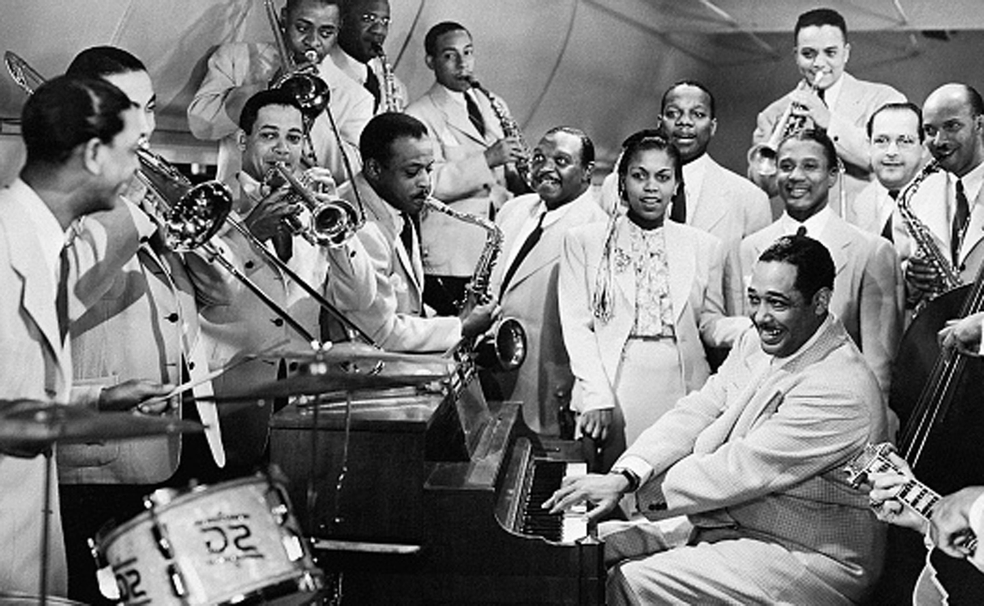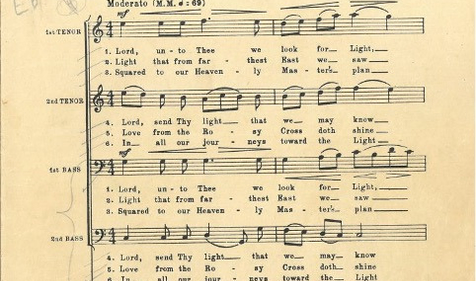Duke Ellington was an American jazz pianist, composer, band leader, and Freemason. Our blog explores his life and connection to Freemasonry.
“The wise musicians are those who play what they can master.” – Duke Ellington
For centuries, Freemasons have demonstrated a profound love for artistic endeavors, recognizing the power of creativity to convey meaningful messages and stimulate intellectual and spiritual growth. Many musical greats have graced lodge rooms across the world, including a host of jazz musicians. And in the annals of American music, few figures loom as large and influential as Edward Kennedy "Duke" Ellington.
Few know that beyond the spotlight that illuminated his illustrious musical career, there is a lesser-known facet of Ellington's extraordinary life: he was a Freemason. He came to the fraternity in 1932 as his musical career reached new heights. He joined Social Lodge No. 1 in his hometown of Washington, D.C., and later became a Prince Hall Freemason.
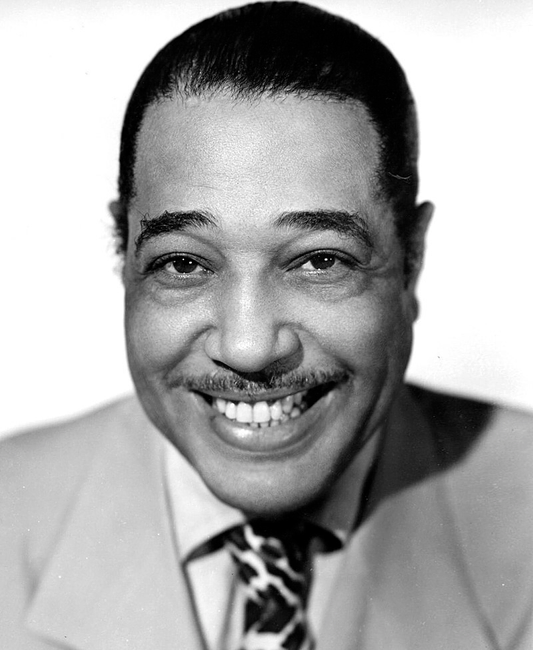
Renowned as a pioneering force in jazz, his innovative compositions and charismatic performances left an big impact on the 20th century. This article delves into the life and career of Brother Ellington and discovers how this musical genius created the most extensive body of work in jazz history.
The Soda Jerk
Brother Duke Ellington was born on April 29, 1899, and was destined for a life of musical brilliance that would later earn him the title of "America's foremost composer." His parents, James Edward and Daisy Ellington, were pianists living in the West End neighborhood of Washington, D.C.
Brother Ellington's interest in music emerged at an early age, and he began piano lessons around the age of seven. His mother played a pivotal role in fostering his love for music, exposing him to classical and popular tunes while teaching him the value of discipline and hard work. She also surrounded her son with dignified women to reinforce his manners and teach him elegance. Brother Ellington’s childhood friends noticed that his casual, offhand way and dapper dress gave him the bearing of a young nobleman, earning him the title "Duke." Of his friend Edgar McEntee giving him the nickname, Brother Ellington said, "I think he felt that in order for me to be eligible for his constant companionship, I should have a title. So, he called me Duke."
He also recalled that before his interest in music blossomed, he spent his time playing baseball, remarking that President (and fellow Freemason) "Theodore Roosevelt would come on his horse sometimes and stop and watch us play."
Brother Ellington's childhood experiences in Washington, D.C. exposed him to a diverse musical landscape, from the elegant sounds of the church choir to the vibrant rhythms of the local dance halls. During this formative period, he developed a deep appreciation for the different musical genres that would later influence his distinctive style. His passion for music and an innate ability to grasp its nuances set the stage for the remarkable career that would unfold in the years to come.
In the summer of 1914, Brother Ellington worked as a soda jerk at the Poodle Dog Café when he completed his first composition, "Soda Fountain Rag." Still unable to write music, he composed Soda Fountain Rag by ear. Brother Ellington's musical talents continued to blossom, and he formed his first group, The Duke's Serenaders, at 17. This early endeavor marked the beginning of a lifelong journey in which Brother Ellington would become a pioneering force in jazz, blending genres, and experimenting with orchestration.
The Duke's Band
Over the next few years, Brother Ellington learned by watching the ragtime pianists in Washington, D.C., Philadelphia, and Atlantic City as he vacationed with his mother. He took private lessons in harmony from Henry Lee Grant, a Dunbar High School music teacher, and learned to read music studying under Oliver "Doc" Perry. Still a teenager, Brother Ellington played shows in small venues around Washington, D.C., declining an art scholarship to the Pratt Institute in Brooklyn to focus on music.
As the 1920s rolled in, Brother Ellington formed a sextet and graduated to Broadway nightclubs. Before long, his group grew to a 10-piece ensemble. Brother Ellington's approach to leading his band was characterized by a commitment to showcasing the individual talents of each member. He saw each as a unique voice in a larger musical conversation, allowing them the freedom to express themselves within the framework of his compositions. Notably, he recruited trumpeter Bubber Miley, who used a plunger to give his horn a distinct "wa-wa" sound.
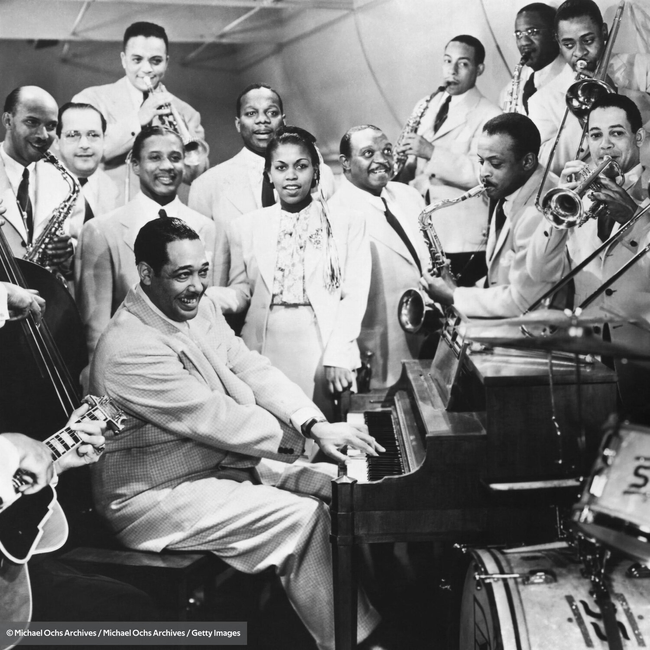
This approach contributed to the band's sound and fostered a sense of camaraderie among its members. The band, often referred to as the Duke Ellington Orchestra, is renowned as one of the most influential and enduring ensembles in the history of jazz. The Duke Ellington Orchestra gained widespread recognition during the early 1930s with their residency at the Cotton Club in Harlem, New York. The band's performances were broadcast nationally, introducing a broader audience to the innovative arrangements and virtuoso soloists that defined Brother Ellington's sound. It was during this period that Brother Ellington composed some of his most iconic pieces, including "Mood Indigo," "Sophisticated Lady," and "It Don't Mean a Thing (If It Ain't Got That Swing)."
In the years leading up to World War II, Brother Ellington reached such prominence that he played annual stints at Carnegie Hall. The arrival of the war brought challenges to the music industry, with many musicians enlisted in the military. Brother Ellington, however, continued to lead his band, adapting to wartime constraints, and maintaining a rigorous touring schedule.
Post-War & Late Career
After the war, popular music shifted towards crooners such as Frank Sinatra and Jo Stafford, and the cost of hiring big bands became increasingly untenable. Club owners sought smaller, more cost-effective groups to perform, and Brother Ellington’s contemporaries, such as Count Basie (also a Freemason) were forced to trim his ensemble. Fortunately, Brother Ellington kept his orchestra together by touring throughout Western Europe and composing higher-profile pieces. After his extended composition, Harlem came out in 1950, he presented its score to President Harry Truman, yet another member of our great fraternity. Brother Ellington also composed the music for a stage production by Orson Welles while he was in Europe.
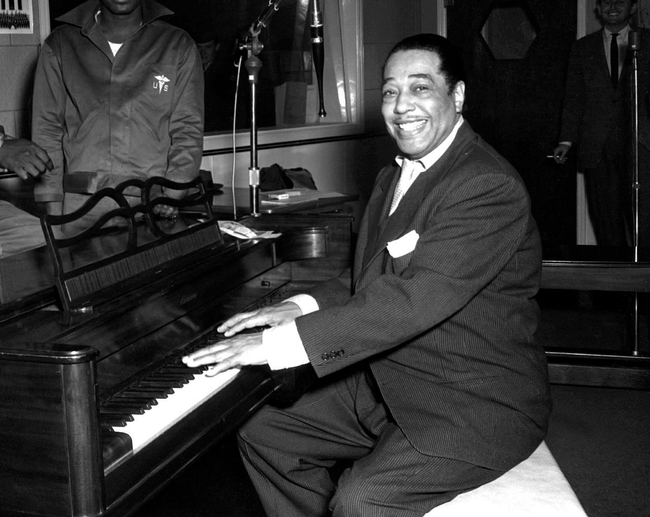
As the 1950s wore on and the 1960s unfolded, Brother Ellington's career entered a new phase characterized by collaborations with other musical greats, experimental compositions, and international recognition. Brother Ellington worked with musicians outside the jazz sphere, including collaborations with orchestral conductor and composer Billy Strayhorn. Their partnership produced masterpieces like "Far East Suite" and "The Perfume Suite," showcasing Brother Ellington's ability to blend different musical genres and influences seamlessly. These compositions further solidified his reputation as a boundary-pushing artist with a keen ear for orchestration and arrangement.
Brother Ellington's late career also witnessed his engagement with the civil rights movement. His iconic performance at the 1963 March on Washington for Jobs and Freedom, where Martin Luther King Jr. delivered his historic "I Have a Dream" speech, underscored Brother Ellington's belief in using music as a force for positive change. The composition "My People," dedicated to the march, stands as a testament to his commitment to social justice.
Brother Ellington received numerous accolades in the latter part of his career, including the Presidential Medal of Freedom in 1969. His orchestral suite, "The First Sacred Concert," premiered in 1965, demonstrated his exploration of spiritual and sacred themes in his music.
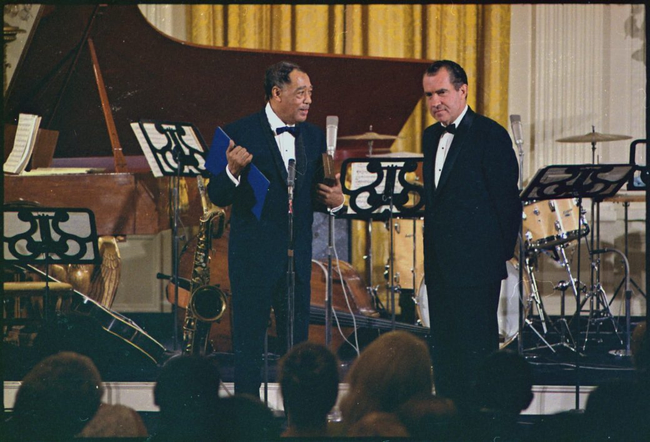
Despite the evolving landscape of music in the late 1960s and early 1970s, Brother Ellington continued to lead his orchestra with energy and creativity. The personnel in his band changed over the years, but Brother Ellington's ability to attract and nurture exceptional talent remained a constant. Some of the most celebrated jazz musicians, including saxophonist Johnny Hodges, trumpeter Cootie Williams, and clarinetist Barney Bigard, were members of the Duke Ellington Orchestra at various points in its history.
His late-career recordings, including the Grammy-winning "And His Mother Called Him Bill," a tribute to his longtime collaborator Billy Strayhorn, showcased Brother Ellington's enduring ability to connect with audiences and remain at the forefront of musical innovation.
Death and Legacy
Brother Ellington died on May 24, 1974, a few weeks after his 75th birthday. Over 12,000 people attended his funeral at the Cathedral of St. John the Divine. Ella Fitzgerald said, "It's a very sad day. A genius has passed."
It's been nearly 50 years since Brother Ellington passed, and throughout the decades, he has been memorialized in cities nationwide. Some of the notable honors he has earned posthumously include:
- In 1974, Washington D.C. renamed the Calvert Street Bridge the Duke Ellington Bridge.
- In 1986, a United States commemorative stamp featuring Brother Ellington's likeness was issued.
- In 2009, the United States Mint issued a coin with Brother Ellington on it. He became the first African American to appear by himself on a circulating U.S. coin.
- In 1996, The Essentially Ellington High School Jazz Band Competition and Festival, a national competition for prestigious high school bands, was formed.
In the true spirit of a Freemason, Brother Ellington's estate continues to preserve his legacy through the Duke Ellington School of the Arts in Washington, D.C. The school educates talented art students and provides academic programs to prepare them for post-secondary education and professional careers. The Ellington Fund, the school's charitable arm, provides critical support for this work, including counseling, tutoring, and college guidance to prepare talented young artists for higher education and careers.
The Duke Ellington Orchestra is a testament to the enduring power of collaborative creativity and the genius of its visionary leader. Duke Ellington's career spanned five decades, and his enduring leadership and musical vision allowed his band to leave an indelible mark on the jazz world and influence generations of musicians who followed in their footsteps.
Related Stories
Discover additional Scottish Rite blogs and news on this topic.
